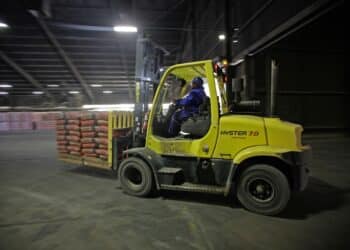Lease returns drive 29% jump in used forklift inventory
Used telehandler inventory rose 20% YoY in October
Lease returns and steep depreciation curves resulted in a glut of used materials handling equipment inventory last month.
While equipment lenders have identified growth opportunities in the materials handling sector, several large players in the forklift leasing market are seeing a lot of returns, Jim Ryan, equipment lease and finance manager at Sandhills Global, told Equipment Finance News.
“As inventory grows, the ‘want to’ of those companies to buy those back is just not there because they can get it cheaper on the open market right now,” he said. “In years past, when lift inventory was hard to come by, we had a lot of renewing leases, buying them back, whatever the case may be. And this is a year where inventory is plentiful. [Customers] are not having an issue getting new, so they’re returning a lot of that stuff.”
Dealers, meanwhile, are mitigating challenges tied to lease returns by moving more used equipment into their rental fleets, Ryan said. Tariffs and other macroeconomic challenges are also prompting materials handling dealers to expand their rental fleets amid hesitancy to purchase, he said.
“A lot of people are more skeptical to buy with all the things going on in that realm,” he said. “You’re seeing the dealers realizing that. … As long as this is still ongoing, they’re going to find a way to capture some money on [the rental] side.”
Nonetheless, forklift and aerial equipment markets remained overrun with used inventory in October, according to Sandhills.
Used forklifts
- Inventory increased 29.1% year over year and 0.8% month over month;
- Asking values dipped 1.5% YoY and 0.6% MoM; and
- Auction values fell 7.8% YoY and 0.1% MoM.
Used aerial lifts
- Inventory rose 3.5% YoY and 1.2% MoM;
- Asking values dropped 5.8% YoY and 1.3% MoM; and
- Auction values fell 6.7% YoY and 0.6% MoM.
Used telehandlers
- Inventory jumped 19.8% YoY, but dipped 0.5% MoM;
- Asking values decreased 4% YoY and 1.6% MoM; and
- Auction values dropped 6.4% YoY and 2.9% MoM.
Navigating depreciation
Depreciation concerns tied to electric forklifts and high disposal costs for lithium-ion batteries are also throwing a wrench in the used market, Ryan said. High disposal costs can suppress resale values and deter purchases of used electric machines, he said.
“It costs more to get rid of the batteries than it does the machine,” he said. “With some of the electric stuff that [dealers] are getting back, they’re seeing extremely high hours. … Now, what value is there to scrap it? You’re almost paying somebody to take it because of the lithium-battery components or whatever the case may be.”
Dealers should strive to offload used forklifts before hitting the 10,000-hour mark, when values begin to drop significantly, Jason Rigney, senior territory sales manager at Yakima, Wash.-based Mid Columbia Forklift, said in a blog post.
“Since most consumers won’t purchase a forklift with over 10,000 hours, the dealership has to invest more money into the unit to justify the resale price,” he said.
Battery maintenance is also crucial, Rigney said.
“A dead battery means a dead forklift,” he said. “For electric forklifts, the battery must hold a charge. If the charger is included with the trade, it can significantly increase the forklift’s value.”
Register here for the free Equipment Finance News webinar “Tech-driven risk management: How innovation is reshaping equipment finance” set for Tuesday, Dec. 9, at 11 a.m. ET.











